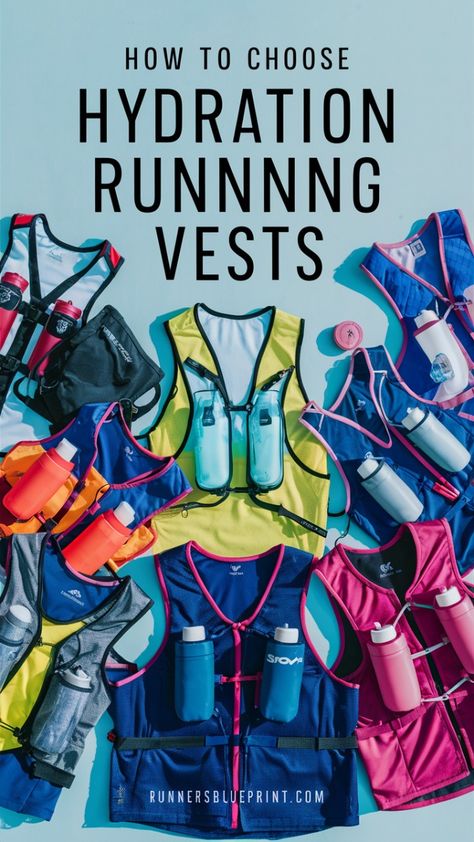If you’re serious about running, especially if you’re into trail running or logging long miles, you’ve probably noticed more and more runners sporting hydration vests.
Hydration vests have become super popular lately, and it’s easy to see why. Not only do they help you stay hydrated, but they also allow you to carry the essentials without any annoying bouncing or discomfort.
But how do you choose the right running vest with many options?
So today, I’ll break down what to look for in a hydration vest—everything from comfort and fit to capacity and cool features.
What is a Running Vest?
Unlike regular hydration packs for hiking or cycling, running vests are designed specifically for runners.
With a running vest, everything you need—water, snacks, phone—stays right within reach, letting you stay in the zone without breaking your stride.
Instead of fumbling for a bottle in your hand or pocket, the hydration vest lets you sip while on the move, making it easier to maintain your pace and stay hydrated.
Running hydration vests are usually made with lighter-weight materials that help wick sweat and keep your body comfortable and dry. They also tend to be less bulky and smaller to help keep the weight down.
What’s more?
A good running vest features straps specifically designed to help reduce movement and bouncing of the pack while pounding the pavement or trails.
A Personal Experience
The first time I knew I needed one was when I just signed up for my first 30K trail race, and halfway through training.
At the time, I realized a handheld water bottle just wasn’t going to cut it for the long distances.
I went with a lightweight running vest with about two liters of fluid capacity and lots of pockets for my essentials.
That first run with the vest was a game-changer! I could finally focus on my run instead of juggling a bottle.
Plus, I could stash gels, my phone, and an extra jacket with no problem. No bouncing, no chafing—it was like the vest was made for me.
Do You Need a Running Vest?
So, do you actually need a running vest? Well, that depends. For shorter neighborhood runs, you’re probably fine without one.
But a hydration vest can be a game-changer if you’re getting into trail running, running long distances, or just prefer to have your hands free and essentials secure.
What makes running vests a game-changer is their design—they’re made to stay snug and distribute weight evenly, so you don’t end up with aching shoulders or a bouncing pack
And good news: thanks to the surge in popularity, more options are now available than ever—meaning you’re bound to find something that fits your style and budget.
Fluid Capacity vs. Pack Capacity: What’s the Difference?
When I first started looking into hydration vests, the different capacities totally confused me. Here’s a simple breakdown that helped me
- Fluid Capacity refers to how much water (or other liquids) the vest can carry. Some vests come with bottles, others with reservoirs (also called bladders), and some with both. The amount of liquid you can carry will range from around 20 ounces to two liters or more.
- Pack Capacity refers to how much additional gear the vest can hold. If you’re heading out for a short run, you might not need much room beyond a phone or a gel. But if you’re planning a longer run or hitting the trails, you’ll want enough space for trail essentials like extra clothing, snacks, a headlamp, and other necessities.
These were two of the biggest questions I had when I was shopping around for my first vest
I didn’t know how much I needed. Should I go for something small for shorter runs or something bigger for when I start pushing those ultra distances?
Here’s how I broke it down based on my running time:
I found that a pack with about two liters of fluid capacity was enough for runs lasting up to two hours. Anything longer, especially on trails, and I’d go for something that could hold more water and space for fuel.
Let me explain more.
How Much Fluid and Space Do You Need?
How much water and space you need really comes down to the type of run you’re doing. Longer trails or rugged terrain usually call for more supplies.
Let me explain more:
- Runs lasting 1 hour or less: You probably don’t need a vest unless you’re in extreme heat or need to carry a few essentials.
- Runs for 1-2 hours: Look for a vest with about 1-2 liters of capacity.
- Runs for 2-3 hours: Go for a vest with a capacity between 2-4 liters.
- Runs over 3 hours: Aim for a vest with 4-10 liters of capacity.
- Ultra-marathons or all-day adventures: You’ll want a pack that can carry at least 8 liters, and possibly more, depending on your specific needs.
The trick is to find that balance—enough water and gear for your needs, but not so much that you feel weighed down.
How Should a Running Vest Fit?
Fit is everything! My first vest hugged all the wrong spots, and it took some testing to find one that felt just right.
Look for a fit that feels secure but doesn’t make you feel restricted. It’s a bit of trial and error, but the right one should almost feel like a part of you on the run.
You don’t want it too tight, but you don’t want it bouncing around as you run. Some vests come in universal sizes, but many offer adjustable straps to customize the fit to your body shape.
For women, looking for a vest with adjustable chest and torso straps is especially important to ensure it fits comfortably above or below your chest. This extra adjustability can make a huge difference in comfort, especially on longer runs.
One thing I learned the hard way is to make sure there’s no space between the straps and your shoulder. If there is, the vest will bounce around and drive you crazy during your run.
Key Features to Look For
Here are the extra features I always look for when I’m picking out a vest:
- Pockets: Pockets are a lifesaver. The more accessible, the better—I hate having to stop and dig around mid-run just to grab a gel or check my phone. Look for a vest that offers easy access to your essentials without stopping or digging around.
- Pole Holders: If you’re into trail running, having pole holders is a nice bonus. I don’t use poles often, but when I do, it’s a lot better than carrying them awkwardly in my hands.
- Reflectivity: Running at dawn or dusk? Reflective details make a big difference for safety, especially on early morning or evening runs.
- Bladder vs. Bottles: Some vests have a bladder (a large, flexible water reservoir) that sits against your back, while others use bottles in the front pockets. Personally, I prefer bottles up front—they’re easier to grab and refill. But if you’re someone who likes a large water supply, a bladder might be better.
Top Hydration Vests for Every Distance
Choosing the right hydration vest can make all the difference in your run. Whether you’re gearing up for a short trail run, a mid-distance race, or an ultra-marathon, here are some of the best hydration vests available, designed to suit your distance and hydration needs.
For Short to Medium Distances: Nathan QuickStart 4L Hydration Vest
The Nathan QuickStart 4L vest is a lightweight, minimalist option perfect for shorter runs or races where you only need a small amount of hydration. With a 1.5L bladder and multiple pockets, this vest gives you easy access to essentials without weighing you down.
- Reservoir Capacity: 1.5L bladder
- Storage: 4L of storage space for small items like gels, keys, and phone
- Unique Features: Soft mesh shoulder straps for comfort, front storage pockets for quick access, and reflective details for visibility in low light
- Best For: Short to mid-distance runs and races, up to around 10-15 miles
Coach’s Tip: This vest’s compact design and simple storage options make it a great choice for runners who need hydration but don’t want a bulky pack.
For Mid to Long Distances: Salomon ADV Skin 5 Set
The Salomon ADV Skin 5 Set vest is a popular choice among trail and distance runners for its balance of hydration capacity, storage, and comfort. It’s lightweight and designed to mold to your body, providing a secure fit that minimizes bounce even on technical terrain.
- Reservoir Capacity: Comes with two 500ml soft flasks, with space for a 1.5L bladder if needed
- Storage: 5L of storage for additional gear, snacks, or a light jacket
- Unique Features: Stretchy, breathable fabric that conforms to the body, expandable pockets for gear, and pole attachments for trail running
- Best For: Mid to long-distance runs, 15-25 miles, where you might need extra gear or hydration
Coach’s Tip: This vest’s front-loading hydration design allows you to balance the weight across your chest, which can reduce shoulder fatigue on longer runs.
For Ultra Distances: Ultimate Direction Ultra Vest 6.0
If you’re tackling ultra-marathons or long trail adventures, the Ultimate Direction Ultra Vest 6.0 is built for you. It offers extensive storage space and hydration capacity, plus features to keep you going through tough, all-day challenges.
- Reservoir Capacity: Includes two 500ml soft flasks and room for a 2L bladder
- Storage: 10.8L storage capacity for extra clothes, snacks, emergency gear, and more
- Unique Features: Moisture-wicking mesh for breathability, multiple pockets for easy organization, large rear compartment for extra storage, and dual trekking pole attachments
- Best For: Ultra-distance events or long trail runs of 25+ miles where ample hydration, nutrition, and gear are essential
Coach’s Tip: The Ultimate Direction Ultra Vest is perfect for those long, unsupported runs where you need to carry everything with you. With room for hydration, food, and gear, it’s an ideal choice for endurance athletes.
For Cold Weather Runs: CamelBak Ultra Pro Vest
The CamelBak Ultra Pro Vest is designed for versatility, featuring insulated components that help prevent water from freezing in cooler conditions. This vest is lightweight and fits snugly, ideal for marathon training or colder weather.
- Reservoir Capacity: Comes with two 500ml Quick Stow flasks; option to add a 1.5L bladder
- Storage: 6L storage for gloves, a hat, or nutrition
- Unique Features: Insulated bottle sleeves to prevent freezing, reflective details for safety, and breathable mesh to prevent overheating
- Best For: Cold-weather runs, marathons, or training sessions where you want water on hand but need extra layers or gear
Coach’s Tip: Cold weather running? This vest’s insulated features help keep your water from freezing, making it easier to stay hydrated on brisk days.
Conclusion
A running hydration vest can be a great investment, especially if you’re into longer or trail running. The key is finding the right balance between fluid capacity, pack capacity, and fit. Make sure to try a few options, and don’t rush the decision—after all, comfort and functionality are crucial for keeping you hydrated and fueled on the run.
If you’re unsure where to start, check out some of the recommendations above based on your running duration. And remember, while it’s tempting to overpack, try to stick to the essentials. Keep it light, but don’t forget the critical items!
Feel free to drop a comment or question below if you want more advice or recommendations. Stay hydrated, keep training strong, and happy running!
David D.


